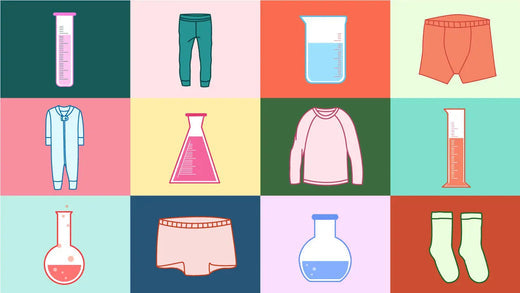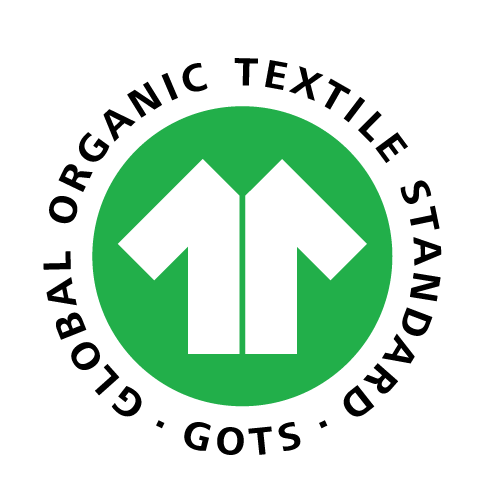There are thousands of chemical compounds that exist in our modern world, many of which we come across on a daily basis. Many of these toxic chemicals were created with the intention of making our lives easier, unfortunately, despite them being deemed “safe in small amounts”, we are learning that they are incredibly hazardous to our health, the health of our children and ultimately, our planet.
The prevalence of these toxins in personal care products and cleaning supplies have been talked about a lot in recent media. But the existence of them in our clothing? That has yet to be fully exposed. More frightening than anything is the fact that kid’s clothing is especially laden with these chemical compounds.
Wastewater outfall near Sateri Fiber and Jiujiang Jinyuan Chemical Fiber viscose plants in Jiangxi, China
Navigating the research and information around chemicals that are so commonly used among big name retailers can be a challenge. So we are here to help. We have compiled a list of a dozen dangerous chemicals that are commonly used in the textile industry. With this knowledge and some intentional shopping, you and your family can enjoy a wide range of alternative kid’s clothing that is safe for you and the planet.
- BPA (bisphenol A) - BPA is an endocrine disruptor. It can imitate the body's hormones, and it can interfere with the production, secretion, transport, action, function, and elimination of natural hormones.
- Parabens - Parabens are believed to disrupt hormone function by mimicking estrogen. Too much estrogen can trigger an increase in breast cell division and growth of tumors. Paraben use has been linked to breast cancer and reproductive issues.
- Formaldehyde - Formaldehyde is used as a wrinkle-free solution on clothing that will protect it from wrinkles, shrinking. It can cause allergic reactions, runny nose, headache, and dermatitis skin rashes.
- Lead - Lead is used in textile dyes and can accumulate in the body over time. It is highly toxic, causing irreversible effects including damage to the nervous system.
- Phthalates - Phthalates are used in artificial leather and in some dyes. It is toxic to mammals and can interfere with development of the testes in early life.
- PET (polyethylene terephthalate) - PET is a type of polyester. When PET is incinerated during disposal, antimony is released as a carcinogenic gas into our environment.
- PFCs (Perfluorinated chemicals) - PFCs are used to give clothing water and stain resistant properties, PFC’s are related to birth defects, linked to testicular cancer, kidney cancer and obesity.
- NPEs (Nonylphenol ethoxylates) - NPEs are used as surfactants (to allow even dying of fabric) by textiles manufacturers. These toxic chemicals break down in the environment into nonylphenol (NP) and are widely recognized as being extremely toxic to aquatic wildlife. They may also threaten the health of the developing fetus and young children.
- Organotin compounds - Organotin is used as an antifungal agent in a range of consumer products. Organotin compounds can have serious effects on the immune, nervous, reproductive and endocrine system. They may also cause sensitization and have detrimental impacts on the environment.
- Halogenated hydrocarbons - Halogenated hydrocarbons are used as a solvent for dry cleaning, inhalation of chlorinated hydrocarbons can result in liver and kidney toxicity. Exposure of unprotected skin to the solvents used can cause dermatitis.
- PBDEs (Polybrominated diphenyl ethers) - PBDEs are used as a flame retardants and are found in a variety of consumer goods including textiles. The impact of these chemicals include neurodevelopmental effects , neurotoxicity, developmental neurotoxicity, reproductive toxicity, thyroid toxicity, immunotoxicity, liver toxicity and pancreas effects.
- Phosphorus based flame retardants - Flame retardants were once legally required to be applied to children’s clothing. Thankfully this has (mostly) changed since the 1970’s but is still required in loose fitting children’s pajamas. Some animal studies have shown that long-term exposure to flame retardants can lead to cancer. Researchers are looking at the association between flame retardants and thyroid disruption, obesity, and human development.
We all want to assume that major clothing manufacturers are creating ethical clothing and using mindful manufacturing processes. Sadly, the reality is that many of the big name clothing companies we trust are using many of these known toxins in their clothing. One study conducted by Greenpeace found the prevalence of Phalates, Organotins, PFC’s and Antimony in many major clothing retailers, such as Nike, GAP, H&M and Uniqlo, to name a few.
An alarming number of big retailers were tested positive for NPE’s, Phthalates, Organotins and Antimony

Even today loose fitting kids pajamas must be flame resistant
Thankfully, many new clothing companies have taken on the challenge of developing entirely non toxic clothing made with environmentally sustainable materials that are healthy for you and your family.
From organic cottons, natural untreated fiber clothing and new local brands, there are now a wide variety of options for you and your children. A few simple steps can help you find the best possible clothing for your little ones and reduce toxic exposure.
- Whenever possible, look for organic textiles that are GOTS certified. GOTS stands for Global Organic Textile Standard and is the ultimate certification for clothing that has been made both ethically and without the use of toxic substances.
- Focus on the clothing that is closest, namely undies, socks and pajamas. Clothing brand Q for Quinn was created on the belief that clothing being worn for long periods of time and closest to the body should be organic cotton whenever possible. From baby onesies, kids underwear, socks and pajamas, children may be particularly vulnerable to the toxic effects of these close to skin products. (eczema for starters!).
- Avoid flame retardants, by opting for “snug fitting” pajamas and double checking to ensure that they are free from flame retardants. Keep in mind that snug fitting cotton pajamas does not automatically mean they are free from chemicals, just that they are free from flame retardants (at least in most cases).
- Choose diapers, nursing, postpartum and menstrual products that are SAFE, environmentally conscious and ethically produced. At Lil Helper, all of our products are BPA free, phthalate free and heavy metal free. We work to create products that we care about and that we know your family can trust.
A note from Q for Quinn:
As we look at the future of the children’s clothing market, we see a need for safer alternatives when buying kids clothes, not just socks. This does not only impact your young family, but ours too. Since launching our collection of socks in 2017 we have been doing extensive research on the chemicals prevalent in clothing. We want to design everyday basics -- items that will be worn close to skin that are also free from these harsh chemicals. We are excited to announce the addition of organic cotton baby onesies, organic boys and girls underwear and snug fitting organic cotton kids pajamas to our product line. Stay tuned for the product launch this fall by signing up for our newsletter at the bottom of the page!













Leave a comment